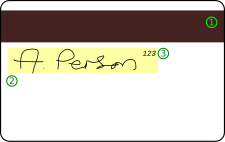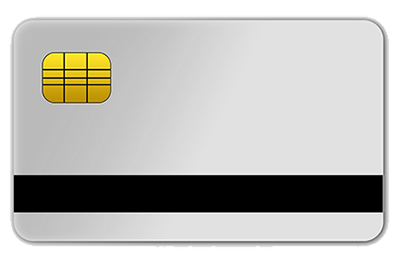id card encoders
Magnetic stripe encoding:

A Magnetic stripe card is a plastic card which has a magnetic stripe on it. Different kinds of information can be stored on the magnetic stripe. Such stripes are usually made of small particles of iron (or another metal). Information is stored by changing the magnetism of the particles, as with magnetic tape Today such cards are widely used for:
- Banking (debit or credit cards)
- Tickets issued for transportation or in parking lots.
- Keys in hotels and other buildings
- Systems to track working hours in companies
There are two types of magstripes: high-coercivity and low-coercivity. A magnetic stripe reader can read either type of magstripe. A high-coercivity magnetic stripe writer may write to only high-coercivity cards. A low-coercivity magnetic stripe writer may write to only low-coercivity cards. Most modern magnetic stripe card readers and encoders support the bi-directional reading of single, dual, and triple track magnetic cards.
The magnetic strip can hold personal details such as account number and name. The strip can contain up to 60 characters, stored magnetically.
To read the data on the card, it is ‘swiped’ through a Magnetic Stripe Reader machine and the data is read and fed back to the computer.

An example of the reverse side of a typical credit card: Green circle #1 labels the Magnatic stripe.
Cards that are used for banking used to store the PIN as a hash value on the magnetic stripe. Today, the ATM calculates the hash value, and transmits it to the server of the bank, which does the comparison. Storing the PIN in the ATM is no longer allowed.
In many payment cards around the world
The format of the three magnetic tracks in standard identification cards:
- Track 1 (IATA)
Up to 79 ALPHA 7-bit (including parity) characters (alphanumeric) including SS, ES and LRC. Read only.
- Track 2 (ABA)
Up to 40 BCD 5-bit (including parity) characters (numeric) including SS, ES and LRC. Read only.
- Track 3 (THRIFT-TTS)
Up to 107 BCD 5-bit (including parity) characters (numeric) including SS, ES and LRC. Read and write.
- Main Features
- Reliability
- Versatility
- Durability
- Security
Contact and contactless encoding:

The definition of smart card encoding
Smart cards are the size of standard credit card (3.375″ x 2.125″). Similar to a magnetic stripe card, data is stored within the smart card components. A smart card offers added functionality and can hold up to 100 times more data than a standard magnetic stripe ID card. With an expanded degree of processing capabilities, these cards are also tamper-proof and can be reconfigured to add, erase, or edit the data they host.
Of all the technology card options available, smart cards are the most secure. They are also an optimal choice for accommodating a wide variety of sensitive data types, including:
- identification details
- personal information
- financial data
- biometric information
Smart card categorization
These types of technology cards can be categorized into two different camps:
- A contact smart card has an integrated chip. As the name implies, a contact smart card must come into direct contact with the reader to process the information embedded within the chip.
- A contactless smart card has a chip and an antenna. In order for the data on the card to be read, it needs to come within a specified distance to the card reader (this distance varies by smart card reader) but does not need to make direct contact.
How to encode smart cards
To encode a contact or contactless smart card, you’ll need an ID card printer with smart card encoding capabilities such as:
- Espresso Printer
- XID Printers
Additionally, you’ll need fully-featured ID software.
When ordering the printer, you’ll need to specify whether you require contact or contactless encoding.
If you have additional questions on how to encode smart cards for both contact and contactless cards contact us.
- Main Features
- Safe and secure
- Authentication
- Encryption
HID® OMNIKEY®

The OMNIKEY® 5422 represents the ultimate combination of contact and contactless technology in a single device. The solution features a dual interface, PC-linked reader that reads / writes to both a 13.56 MHz contactless smart card and virtually any contact smart card to support environments where both contact and contactless smart card technologies are required.
The reader provides users with the convenience, speed and security for applications such as user authentication to PCs, software, cloud-based applications, networks and web sites.
The OK5422 eliminates the requirement for driver installation and is suitable to be used with standard PC or workstations, as well as with thin and zero clients.
Benefits:
- Versatile – Ideal for end-user environments using both contact and contactless smart card technology and migration scenarios
- Leverages existing employee badge – Expands the usage of existing physical access cards to computer logon, as well as network and cloud applications.
- Easy to install – Eliminates the need to install drivers; uses native supported CCID drivers within the operating system.
- Increased security and improved user experience – Read and retrieve highly secure one-time passwords (OTP) from Seos® card.
Card Interface
- Contact ID-1
- Contactless 13.56 MHz
Credential Support
- ISO 7816 Contact Cards
- ISO 14443 A/B Contactless Cards
- CRESCENDO
- HID iCLASS® / MIFARE® Classic / Ultralight /DESFire EV1
Solution compatibility
- ActivID® ActivClient
- ActivID® Applets
Optional Accessories
- Mounting accessories kit
- Card Holder for Card Presence operation
- Standing Base
- Main Features
- Easy to install
- Safe and secure
- Increased security and improved user experience
- Encryption
- Versatile
